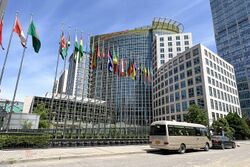Organization:International Bamboo and Rattan Organisation
 Headquarters of INBAR in Wangjing, Beijing, China | |
| Abbreviation | INBAR |
|---|---|
| Formation | 1997 [1] |
| Type | Independent intergovernmental organization |
Region served | Worldwide |
Official language | English, French, Spanish and Mandarin |
Director General | Ali Mchumo |
Staff | 60+ |
| Website | www |
The International Bamboo and Rattan Organization (INBAR[2]) is an independent intergovernmental organization[3] established in 1997 to develop and promote innovative solutions to poverty and environmental sustainability using bamboo and rattan.[4]
History
INBAR evolved from an informal network of bamboo and rattan researchers set up in 1984 by the International Development Research Centre (IDRC) of Canada . The name "International Network for Bamboo and Rattan" was chosen in 1993. Work to launch INBAR as an independent organization started in 1995, and was completed in 1997 when INBAR became an independent organization with its headquarters in Beijing, China.[5] Bangladesh, Canada , China , Indonesia, Myanmar, Nepal, Peru, the Philippines and the United Republic of Tanzania made up INBAR's nine founding members. Since then, INBAR has grown considerably in strength and scope away from a research-only organization and towards a more action-focused mandate. In November 2016 the name of the organization was changed to International Bamboo and Rattan Organization to reflect this change.
Membership and structure
Membership of INBAR is open to member states of the United Nations and to intergovernmental organizations. INBAR currently has 48 Member States. INBAR's supreme governing body is its Council of representatives of its Member States, which meets biennially. The Board of Trustees, made up of appointed experts from relevant fields from many countries, is the second tier of governance, and develops appropriate policies, oversees management and ensures efficient operations at its annual meetings.
The Director General is a member of the Board of Trustees and is responsible for day-to-day running of the organization. The current Director General is Ambassador Ali Mchumo.[6]
INBAR's headquarters is in Beijing, China , and it has regional offices in South Asia (New Delhi, India ), Central Africa (Yaoundé, Cameroon), East Africa (Addis Ababa, Ethiopia), West Africa (Kumasi, Ghana) and Latin America and the Caribbean (Quito, Ecuador). INBAR is managed by its Executive Management team, which comprises the Director General, Deputy Director General, and the Directors of Global Program, Membership Affairs, Host Country Affairs, and Communications.[7]
Member States as of July 2021
- Argentina
- Bangladesh
- Benin
- Bhutan
- Brazil
- Burundi
- Cambodia
- Cameroon
- Canada
- Central African Republic
- China
- Chile
- Colombia
- Republic of the Congo
- Cuba
- Ecuador
- Eritrea
- Ethiopia
- Fiji
- Ghana
- India
- Indonesia
- Jamaica
- Kenya
- Liberia
- Madagascar
- Malawi
- Malaysia
- Mozambique
- Myanmar
- Nepal
- Nigeria
- Pakistan
- Panama
- Peru
- Philippines
- Rwanda
- Senegal
- Sierra Leone
- Sri Lanka
- Suriname
- Tanzania
- Thailand
- Togo
- Tonga
- Uganda
- Venezuela
- Viet Nam
Publications
INBAR publishes a wide range of publications on bamboo and rattan.,[8] including:
- Manual for the Sustainable Management of Bamboo
- Bamboo for land restoration
- Bamboo and Rattan Yellow Pages
- Road from the Global Bamboo and Rattan Congress 2018
- INBAR Strategy 2015-2013: From Research to Development
- Carbon Sequestration and Carbon Emissions Reduction Through Bamboo Forests and Products
INBAR also publishes a series of fact sheets for the general public about issues related to bamboo and rattan.
- Think Bamboo for Land Restoration
- Why is Bamboo important for the Belt and Road Initiative?
- Why is Bamboo important for Climate Change?
- Bamboo, Rattan and Biodiversity
- Bamboo as a Source of Bioenergy
- Bamboo and the Circular Economy
See also
- Bamboo
- Rattan
- Poverty alleviation
- Sustainable development
- Bamboo construction
References
- ↑ William Nikolakis, John Innes. Forests and Globalization: Challenges and Opportunities for Sustainable Development The Earthscan Forest Library. Routledge, 2014. ISBN:1317660730. Page 173.
- ↑ Eva Wollenberg, Andrew Ingles. Incomes from the Forest: Methods for the Development and Conservation of Forest Products for Local Communities. CIFOR, 1998. ISBN:9798764196. Page 58.
- ↑ Srivastava, P. B. L. (1998). Management and Utilization of Bamboo and Rattan in Papua New Guinea. ISBN 9788186247358. https://books.google.com/books?id=-s0sAQAAMAAJ&q=%22International+Network+for+Bamboo+and+Rattan%22. Retrieved December 8, 2015.
- ↑ "This is INBAR". http://www.inbar.int/this-is-inbar. Retrieved December 8, 2015.
- ↑ Kumar, Arun; Sastry, Cherla B.. "The International Network for Bamboo and Rattan". FAO. http://www.fao.org/3/x2450e/x2450e0a.htm. Retrieved 1 June 2019.
- ↑ "Former Tanzanian envoy lands top job". The Citizen. 8 April 2021. https://www.thecitizen.co.tz/News/Former-Tanzanian-envoy-lands-top-job/1840340-5044062-140fw9fz/index.html.
- ↑ "Headquarters Secretariat". https://www.inbar.int/hq-secretariat/#2.
- ↑ resource.inbar.int
External links

